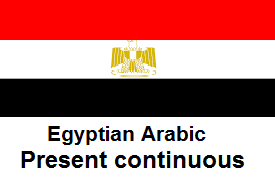Language/Egyptian-arabic/Grammar/Present-continuous
The present continuous tense in Egyptian Arabic is used to describe an action that is currently in progress or happening at the moment of speaking. In this lesson, we will cover the basic structure and usage of the present continuous tense in Egyptian Arabic and provide examples to help you understand and apply this tense in practice.
Structure
The present continuous tense in Egyptian Arabic is formed by combining the present tense form of the verb "to be" (habe) with the present participle form of the verb. The present participle form of the verb is typically formed by adding "een" to the end of the root verb. For example:
- "sallem" (to greet) becomes "sallameen" (greeting) - سَلَّم becomes سَلَّمِين
- "rakib" (to drive) becomes "rakbeen" (driving) - راكب becomes راكبِين
Usage
The present continuous tense in Egyptian Arabic is used to describe an action that is taking place at the moment of speaking, or a temporary situation that exists now. For example:
- "Ana rakbeen fi el qahira" (I am driving in Cairo) - أنا راكبين في القاهرة
- "Wahid sallemeena bi yomen" (Someone is greeting us today) - واحد سَلَّمِينا بِيومِين
It is important to note that the present continuous tense in Egyptian Arabic is not used to describe a permanent or long-term situation. For these cases, the present tense is used instead.
Practice
To practice using the present continuous tense in Egyptian Arabic, try constructing sentences using the examples provided, or make up your own sentences describing actions happening at the moment of speaking. It is also helpful to listen to native speakers using this tense in conversation and pay attention to how they use it in different contexts.
With practice and exposure, using the present continuous tense in Egyptian Arabic will become second nature and you will be able to communicate effectively and confidently in the language.
More examples
| انا بشوف | ana bachuuf | I am seeing |
| انت بتشوف | You are seeing | |
| inta bitichuuf | ||
| هي بتشوفي | She is seeing | |
| Héia biichuuf | ||
| احنا بنشوف | We are seeing | |
| eHna binichuuf | ||
| انتو بتشوفوا | You are seeing (pl) | |
| intuu bitichuufu | ||
| هم بيشوفوا | They are seeing | |
| Húma biichuufu | ||
| انا ما بشوفش | I am not seeing | |
| ana maa bachuufch | ||
| انت ما بتشوفش | You are not seeing | |
| inta maa bitichuufch | ||
| هي ما بتشوفيش | She is not seeing | |
| Héia maa biichuufiich | ||
| احنا ما بنشوفش | We are not seeing | |
| eHna maa binichuufich | ||
| انتو ما بتشوفوش | You are not seeing (pl) | |
| intuu maa bitichuufuuch | ||
| هم ما بيشوفوش | They are not seeing | |
| Héia maa biichuufuuch | ||

